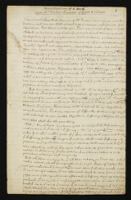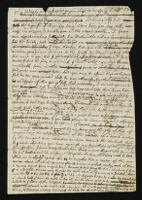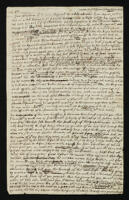Records the purchase of 4 and a half yards and a quarter from Obadiah Wickes and Daniel Radford at 'the 3 Nunns & Hare in Cheapside' for 1 pound 17 shillings.
Acknowledges receipt of a Newton letter dated 3 July 1684. With later note below, 'Received again by Trinity 20 Mar. 1990. DMcK [David McKitterick, Librarian of Trinity College].
7 Camden Street, Camden Town - He has been meaning to respond to the last point of Whewell's letter on enunciation, but he has been looking through the proofs of an account of Newton by David Brewster. He describes how his check of the references has shown a story to be false: the story about Newton being offended by being represented as an Arian by Whiston that he blocked the latter's entry to the Royal Society. De Morgan discusses his definition of enunciation at length.
London, Vere Street, 'near Oxford Chappel'. Sent to Sir Edward Littleton at Fedgeley [Teddesley?] Coppice, Staffordshire. - Apologises for not finishing any more busts. Has had to finish the statue of the Duke of Somerset and some other things to keep his men at work. Has finished four busts for Littleton: Milton; Sir Isaac Newton; Locke; and Bacon; now promises to begin that of Sir Walter Raleigh. Describes work and reason for delays.
Has called on Mr Wilson to see the portrait of Littleton's wife, as Littleton desired, and likes it very much. Ends with wishes for good health of both Littletons.
Rysbrack, John Michael (1694–1770), sculptorIncludes a letter from J. Cates and discussion of letters of Isaac Newton
7 Camden St., Camden Town - M. Biot inquires for the meaning of Newton buying a supersedeas.
7 Camden St., Camden Town - His friend Libri has just bought a Newton letter, part of letters bought by Rodd in 1847, to Sir John of Lincoln [probably John Newton] dated May 23, 1715 - four days after Halifax's death [Charles Montagu, Earl of Halifax] - in which he writes: ''The concern I am in for the loss of my Lord Halifax, and the circumstances in which I stand related to his family will not suffer me to go abroad till his funeral is over''. He believes Newton was related to Halifax through his niece.
7 Camden St, N.W. - Thanks him 'for the Bacon which you found in the Barrow - It all amounts to wondrous little'. If Whewell is right that Bacon was well known with Cambridge men how could he be so little quoted? When he has time he intends to work out the thesis 'That Newton was more indebted to the schoolmen than to Bacon, and probably better associated with them'. He has received Mansel's Bampton lectures: 'I tell him by this post that it is the best argument I have seen against subscription at matriculation'. Discusses Earnshaw's integration of the equation of sound, his own method from 1848 and that of Jacques Charles.
Concerns news of Sir John Herschel at the Cape, and a discovery of Newton's prism in Italy.
Trinity - M. Crelle has been publishing a series of facsimiles, generally concerning the handwriting of a distinguished mathematician, in in the Journal der Mathematik, and AC has 'perhaps rashly' promised to supply him with some English examples. Would WW let him extract two or three letters from the volume of Newton's correspondence in the College library?
Memorandum, 9 Feb. 1839, by 'H. Buck, BA, Trin. Coll. Cam.' certifying that the ruler and part of the compasses once belonging to him by Isaac Newton by Aldous Henshaw, Librarian of Trinity, were delivered to him, and 'correspond in every respect with the remaining instruments of the same kind preserved in the Library of the s[ai]d College'. With label pasted to sheet: 'Part of the Compasses & a rules that formerly belonged to Sir Isaac Newton | The remainder of this set of Inst[rumen]ts was presented to the Library of Trinity Coll. Cambridge'.
Letter, 29 Jul. 1941, from Evelyn E. Fellows, acting for the administrators of the estate of the late Frances Pulteney of Sion House, Birchanger, among whose possessions was found 'this case' [containing the compasses?].
Claims that the statue 'when first executed by Roubiliac and before it left his Studio, had the lips closed'; this was first noted in the piece on Byron's Childe Harold in the Eclectic Review, whose editor Josiah Conder had married Roubiliac's niece [actually, his granddaughter]. 'It is likely that the story was traditional in the family, tho never heard of in this place'.
Signed 'F. T. Cambridge'.
Copy of three original letters: from Isaac Newton to Roger Cotes dated 5 Mar. 1713, with an addition from Bentley, with a letter from Cotes dated 25 June 1713 to Samuel Clarke.
37 Tavistock Place - FB has 'for a long time past, had it in contemplation to give a new edition of Flamsteed's [John Flamsteed] British Catalogue [An Account of the Rev. John Flamsteed...to which is added his British Catalogue of Stars, Corrected and Enlarged, 1835]; and this intention is now fully confirmed by the recent & singular discovery of Flamsteed's M.S.S. at the Royal Observatory'. Through JF's original computing book 'I have been enabled to detect the source of most of his errors, & to rectify them accordingly'. In producing this amended and enlarged edition of the British Catalogue, it will not be possible for me (neither would it be fair or just to the memory of Flamsteed) to conceal the various other matters contained in those M.S.S...You will readily see, from the tone of Flamsteed, that he is very sore respecting the part which Newton took in the publication of the "Historia Celestis"...I am anxious, before I publish any thing, to discover (if possible) whether there are any M.S.S. in existence that will throw any light on this subject, & tend to set the character of Newton, in this business, in a fairer point of view'. Could GP check the Newton manuscripts and also inform WW. FB would like to see the whole of the manuscripts of Newton, in the possession of the University, published: 'There never was a time when they would be hailed with so much pleasure & satisfaction'.
Royal Observatory Greenwich - Answers WW's queries: when Newton's 'analysis is carried to perfection (i.e. so as to shew Fraunhoffer's lines), it has certainly developed original properties of light... Their existence in the diffraction spectrum tends most strikingly to confirm this. - You may also say that persons who have tried the experiments with great care do not believe in [David] Brewster's changes of colour. - The changes of colour are certainly the only source of his objections'. The French have always associated Thomas Young with the discovery of the undulating theory of light.
'Newton's Work in Physics', Yorkshire Branch of the Mathematical Association, Grantham, Lincolnshire, 20 March 1927.
Letter from the University of Leeds re the Sir Isaac Newton Bicentenary Celebrations organised by the Yorkshire Branch of the Mathematical Association, 16 April 1926
Copy of three original letters: from Cotes to Bentley 10 Mar. 1713, from Bentley to Cotes, undated, and from Isaac Newton to Cotes 5 Mar. 1713.
7 C. St. & T. - Can not find that letters from Newton to Keil in 1714 have ever been published, hopes he will [gain?] them.
Endorsed with date and note, 'His Hypothesis about the Attraction & moving of the Heavenly Bodies'.
Printed menu for Newton 350th Anniversary Dinner, held on 3 July 1992. Newcutting, The Times "Saturday Review", 4 July 1992: new poem, Newton Enigmas, by Ben Okri, commissioned by the Master of Trinity, Sir Michael Atiyah, to mark the anniversary and performed for the first time by the Trinity College choir at the 3 July dinner in a setting by Richard Marlow, director of Music at Trinity.
Trinity College, CambridgeKings College - Concerning the portrait of Isaac Newton that he helped Trinity College procure.
MS copies of the correspondence of Newton and Roger Cotes and others, gathered in preparation for Edleston's Correspondence of Sir Isaac Newton and Professor Cotes, including Letters of Other Prominent Men (London, 1850). This group of copies does not include all of the letters printed, but does include some materials gathered for the notes to the life of Newton at the front of the volume. There are a letter from Dawson Turner dated 24 Mar. 1848 forwarding a transcription of a letter from Bentley (not present) and referring to other letters in his collection, and three printed figures, two of which were printed in the volume.
Edleston, Joseph (1816-1895) Fellow and Bursar of Trinity College CambridgeAsks on behalf of M. Biot what is meant by supersedeas in Newton's 'otiore expensa'. He has written an article on Richard Sheepshanks for the Examiner; wonders who will have both power & leisure to help young observers now.
Morgan, Augustus De (1806-1871), mathematician and historianA note accompanying the letter is written on the back of a card from Tressilian Nicholas to Herbert Mayow Adams, dated 19 Jul., about a 'proposed visit to Cheltenham to inspect the Newton books'. The note explains that when Bucknall refers to 'the operations which we studied in your College', he means 'the military conference held in Trinity COllege from March 28th to April 1st 1944 , which laid plans for the invasion of France in June 1944.'




